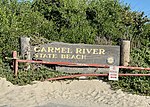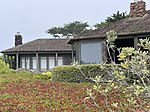Rancho San José y Sur Chiquito was a 8,876-acre (35.92 km2) Mexican land grant in present-day Big Sur, in Monterey County, California, given in 1835 to Teodoro Gonzalez and re-granted by Governor Juan Alvarado the same year to Marcelino Escobar. The grant, including Point Lobos, was located south of the Carmel River, extending inland along the coastal mountains, and south along the Pacific coast. It included San Jose Creek, Malpaso Creek, Soberanes Creek, Tres Pinos Creek, Garrapata Creek, and ended on the north side of Palo Colorado Canyon. A hand-drawn map created c. 1853 accompanying the grant indicated a road or trail was already present along the coast.Two of Escobar's ten children sold the land to Josefa Abrego, who may have been acting for her husband, José Abrego. She later transferred the title to a group of about 10 Mexican soldiers at no cost, who according to legend might have received it in payment of a gambling debt incurred by José Abrego. They gave it to José Castro, their superior officer. When Alta California was ceded to the United States government, Castro was required to prove his title. He submitted a claim in 1853, but he died before it was resolved. His successors were denied the patent claim and appealed the court decision. The other Escobar children attempted to claim their portion of the land, and do did many others. Thirty-two claimants eventually asserted that they owned a portion of the land. Thirty-five years later, in 1886, Castro's successors finally obtained clear title, forcing all other claimants out.
The land was by then used by Chinese, Japanese, Azores, and Anglos for a variety of purposes, including ranching, dairy, farming, mining, whaling, a granite quarry, and an abalone cannery. In 1890, the owners converted their title into stock of the Carmelo Land and Coal Company. When the coal mine failed, the owners submitted a plan for a 1,000 lot subdivision. Alexander Allan bought Point Lobos in 1898 and began efforts to preserve the land against development. One portion was sold by successors to form the existing Carmel Meadows subdivision. In 1933, the State of California bought Point Lobos and formed a state park. Portions of the inland portion of the grant became Garrapata State Park. The A.M. Allan ranch across from Point Lobos was sold to the State of California and has been set aside as a possible future state park.










